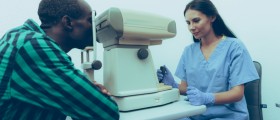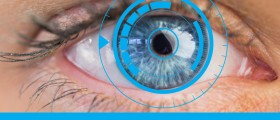
Chronic central serous chorioretinopathy, also known as central serous retinopathy, is a serious visual impairment which in many patients affects one eye only. The condition predominantly occurs in individuals between the age of 20 and 50 and is more frequent among men. In its active phase the disease leads to leakage of fluid under the retina. This fluid mostly gets under the central macula, hence the term central chorioretinopathy. The overall result of such fluid build-up is distorted vision. Initially, patients report a blurred or gray spot in the central part of the field of view. Visual problems remain until the fluid is reabsorbed.
Diagnosing Chronic Central Serous Retinopathy
Patients undergo thorough ocular examination as well as optical coherence tomography and fluorescein angiography which all help an ophthalmologist to confirm the diagnosis. The angiography is of great help in visualizing one or more fluorescent spots that occur due to fluid leakage. These may occur in a "typical" smoke stack pattern. An Amsler grid is an amazing tool used in order for the doctor to determine the precise location of the visual field affected by the disease.
Causes of Chronic Central Serous RetinopathyAll the symptoms of chronic central serious retinopathy develop as a result of detachment of macula layers from the supporting tissues due to fluid build-up. Such build-up is possible because of the presence of small breaks in the retinal pigment epithelium through which the choroidal fluid enters the subretinal space.
Idiopathic central serous retinopathy has no identifiable underlying cause. The condition may be associated with stress and is reported to occur more among people with stressful occupations (e.g. airplane pilots).
Chronic central serous retinopathy is also connected with the use of corticosteroids and cortisol. Some experts believe that the condition affects more people suffering from MPGN type II kidney disease. And finally, recent studies have pointed to possible connection between the condition and gastritis caused by Helicobacter pylori.
Treatment and Prognosis
Patients who are under stress and in whom the illness may be stress-related require counseling. The condition is treatable and usually withdraws within several months.
Cases of chronic central serous retinopathy in which there is a single or a few sources of leakage located at a safe distance from the fovea are successfully treated with laser photocoagulation. Leakage in the central macula can be dealt with transpupillary thermotherapy. In people who are on treatment with corticosteroids the therapy should discontinue while people suffering from Helicobacter pylori require eradication of the bacterium.
The prognosis of the condition is quite good. As a matter of fact up to 90% of all patients restore 20/30 vision or their vision drastically improves within the period of six months. Permanent complications which affect some patients include decreased night vision, color discrimination problems, subretinal neovascularization and pigment epithelopathy.

















Your thoughts on this
Loading...